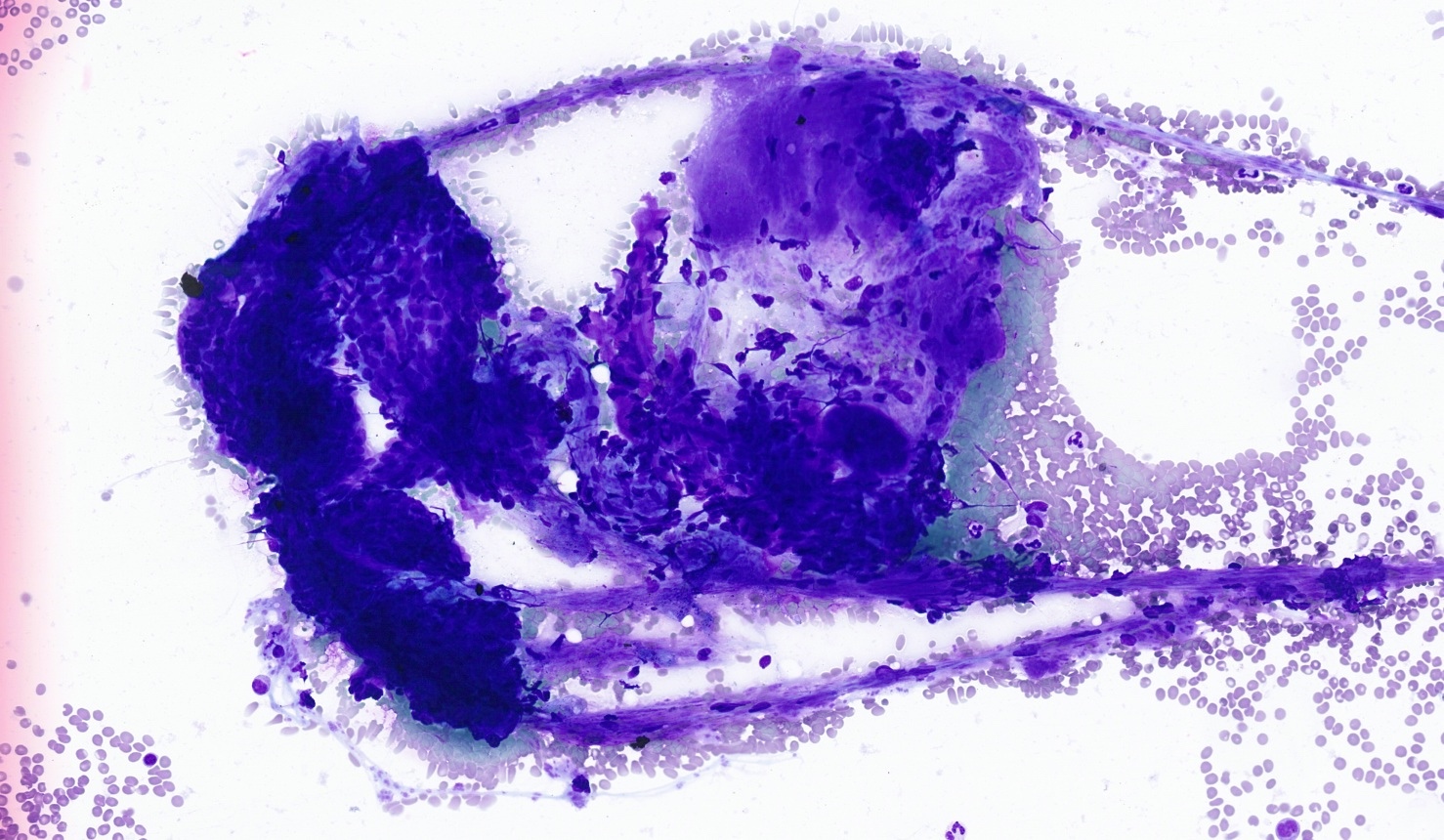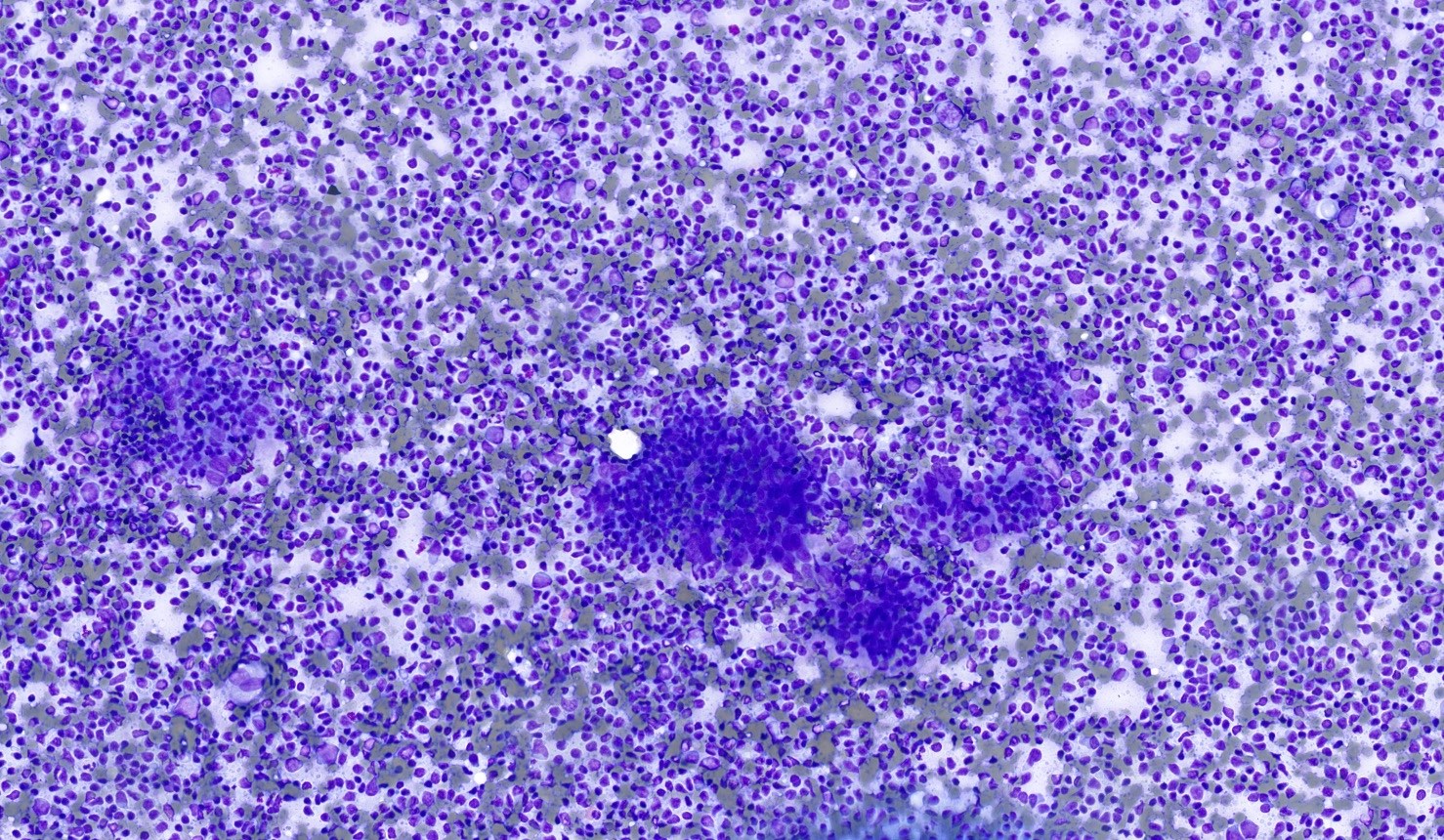Table of Contents
Definition / general | Essential features | CPT coding | Sites | Case reports | Treatment | Cytology description | Cytology images | Sample pathology report | Differential diagnosis | Practice question #1 | Practice answer #1 | Practice question #2 | Practice answer #2Cite this page: Golconda U, Sayeed S. Atypia of undetermined significance (AUS). PathologyOutlines.com website. https://www.pathologyoutlines.com/topic/salivaryglandsmilanAUS.html. Accessed July 21st, 2025.
Definition / general
- A diagnostic category of the Milan System for Reporting Salivary Gland Cytopathology which addresses when the differential diagnosis includes both neoplastic and nonneoplastic lesions (Faquin: The Milan System for Reporting Salivary Gland Cytopathology, 1st Edition, 2018)
- Occasionally, FNAs with atypical cells which may be otherwise considered nondiagnostic are also included
Essential features
- Category is heterogeneous in nature
- Differential includes nonneoplastic and neoplastic entities
- Risk of malignancy is ~20%; the implied risk of malignancy was estimated to be ~20% in the 1st edition of the Milan system but was found to be higher (~30% on average) in subsequent studies with surgical follow up
- It is recommended that no more than 10% of FNAs should be interpreted as atypia of undetermined significance
CPT coding
Sites
- Major salivary glands (parotid, submandibular, sublingual), less frequent in minor salivary glands
Case reports
- 10 year old boy presented with swelling of the left parotid gland (Cytopathology 2021;32:257)
- 55 year old woman presented with a 2 year complaint of fluctuating painless right parotid swelling (J Family Med Prim Care 2020;9:1202)
- 56 year old woman with a 2 year history of a painless mass in the left parotid gland (Acta Cytol 2008;52:369)
Treatment
- Repeat FNA or FNA under ultrasound guidance if prior was palpation guided
- Close clinical follow up
- Additional imaging (such as MRI or CT) for further characterization
- Tissue sampling or surgical excision if clinically suspicious for malignancy
- Reference: Faquin: The Milan System for Reporting Salivary Gland Cytopathology, 1st Edition, 2018
Cytology description
- Atypia in a scant cellularity specimen which may represent reactive or reparative atypia but is indeterminate for a neoplastic process
- Epithelial cells which have squamous, oncocytic or metaplastic changes but have limited cellularity and are indeterminate for a neoplastic process
- Scant cellularity specimens which are suggestive of but not diagnostic of a neoplasm
- Poorly preserved specimens which preclude determination of a neoplastic versus nonneoplastic diagnosis
- A predominantly cystic lesion with a mucinous background with rare or absent epithelial cells
- A lymphoid predominant aspirate in which a hematolymphoid neoplasm cannot be excluded
- Rare atypical cells present when the differential includes a basaloid neoplasm
- Reference: Faquin: The Milan System for Reporting Salivary Gland Cytopathology, 1st Edition, 2018
Cytology images
Sample pathology report
- Parotid, right, fine needle aspiration smears:
- Atypia of undetermined significance
- Scant histiocytes in a background of abundant mucin (see comment)
- Comment: The specimen is limited by scant cellularity. The differential includes a mucinous cyst, though a low grade mucoepidermoid carcinoma is not entirely excluded. Clinical and radiologic correlation is suggested.
- Submandibular, left, fine needle aspiration smears:
- Atypia of undetermined significance
- Heterogenous lymphoid elements (see comment)
- Comment: Insufficient material was available for flow cytometry. Additional sampling with dedicated material for flow cytometry is suggested if clinical suspicion for a lymphoproliferative disorder persists.
- Parotid, right, fine needle aspiration smears:
- Atypia of undetermined significance
- Rare atypical cells (see comment)
- Comment: The specimen is limited by scant cellularity. The differential includes reactive atypia, though a neoplastic process cannot be entirely excluded. Clinical and radiologic correlation is suggested.
Differential diagnosis
- Differential diagnosis of lymphocyte rich aspirates includes:
- Nonneoplastic:
- Chronic sialadenitis:
- Hypocellular aspirate with basaloid (atrophic) or metaplastic ductal cells and few / absent acinar cells
- Chronic inflammation (lymphocytes and plasma cells)
- Lymphoepithelial sialadenitis:
- More common in parotid gland (~90% of cases), in women and associated with autoimmune conditions like Sjögren syndrome
- Cellular aspirate with large sheets of reactive ductal cells with or without squamous metaplasia and percolating mature lymphocytes
- Lymphoepithelial cyst (HIV associated) cyst:
- Associated with autoimmune disease (e.g., Sjögren syndrome) or young HIV+ individuals (usually multiple and bilateral) (Diagn Cytopathol 2012;40:684)
- Proteinaceous and keratin debris with squamous cells (without significant atypia), lymphocytes and lymphohistiocytic aggregates
- Chronic sialadenitis:
- Neoplastic:
- Warthin tumor:
- FNA with predominant dirty granular background material and scant epithelial component can be falsely interpreted as necrosis
- False negative rate: 1.3% (4/304) (Cancer Cytopathol 2021;129:43)
- Mucoepidermoid carcinoma:
- Predominantly mucus cells floating in extracellular mucin (low grade)
- High grade nuclear features with pleomorphic nuclei, prominent nucleoli, intermediate cells and mucous cells are rare
- Predominantly mucus cells floating in extracellular mucin (low grade)
- Acinic cell carcinoma:
- Cells are large but morphologically resemble normal acinar cells
- Round nuclei with small nucleoli
- Abundant finely vacuolated to granular cytoplasm
- Cells are large but morphologically resemble normal acinar cells
- Malignant lymphoma:
- Lymphomas originating from the salivary glands are rare, accounting for ~3% of all malignant tumors which more commonly affect the parotid glands
- Warthin tumor:
- Nonneoplastic:
- Differential diagnosis of lesions that can yield cystic fluid includes:
- Nonneoplastic:
- Obstructive sialoadenopathy
- Retention cyst:
- Mucoid secretion surrounded by a bilayer of cuboidal or columnar stratified salivary duct epithelium
- Mucocele:
- There is no true salivary gland duct epithelial lining and instead this is mimicked by epithelioid macrophages (muciphages) at the periphery of the extravasated mucin
- Lymphoepithelial (HIV associated cyst):
- Associated with autoimmune disease (e.g., Sjögren syndrome) or young HIV+ individuals (usually multiple and bilateral) (Diagn Cytopathol 2012;40:684)
- Retention cyst:
- Neoplastic:
- Warthin tumor:
- Sheets of oncocytes and mixed population of lymphocytes in a characteristic dirty proteinaceous background
- Pleomorphic adenoma:
- Mixture of myoepithelial cells, ductal cells and extracellular stroma
- Mucoepidermoid carcinoma:
- Predominantly mucus cells floating in extracellular mucin (low grade)
- High grade nuclear features with pleomorphic nuclei, prominent nucleoli, intermediate cells and mucous cells are rare
- Predominantly mucus cells floating in extracellular mucin (low grade)
- Acinic cell carcinoma:
- Cells are large but morphologically resemble normal acinar cells
- Round nuclei with small nucleoli
- Abundant finely vacuolated to granular cytoplasm
- Cyst wall with simple lining of glandular cells, oncocytic cells or squamous cells
- Cells are large but morphologically resemble normal acinar cells
- Secretory carcinoma:
- Cohesive clusters or sheets of epithelial cells with variable eosinophilic, granular to vacuolated cytoplasm and uniform nuclei with single nucleoli
- Warthin tumor:
- Obstructive sialoadenopathy
- Nonneoplastic:
Practice question #1
This aspirate smear contains abundant extracellular mucin without epithelial cells. Under which category should this be placed according to the Milan system for reporting salivary gland cytopathology?
- Atypia of undetermined significance
- Nondiagnostic
- Salivary gland neoplasm of uncertain malignant potential
- Suspicious for malignancy
Practice answer #1
A. Atypia of undetermined significance. The image shows abundant extracellular mucin. The differential diagnosis of mucin containing cysts includes mucocele, mucus retention cysts and low grade mucoepidermoid carcinoma. Therefore, atypia of undetermined significance is the correct interpretation on FNA.
Comment Here
Reference: Atypia of undetermined significance (AUS)
Comment Here
Reference: Atypia of undetermined significance (AUS)
Practice question #2
What is the implied risk of malignancy on excision if a diagnosis of atypia of undetermined significance is rendered on a fine needle aspiration (FNA) of the parotid?
- < 5%
- 20%
- 45%
- 90%
Practice answer #2
B. 20%. The implied risk of malignancy is ~20% as per the Milan system for reporting salivary gland cytopathology (1st edition 2018), based on a limited number of studies. However, subsequent studies using the Milan system criteria have found the risk of malignancy for a diagnosis of atypia of undetermined significance with surgical follow up to be significantly higher (30% on average) with wide variations across institutions that reflect different types of practices.
Comment Here
Reference: Atypia of undetermined significance (AUS)
Comment Here
Reference: Atypia of undetermined significance (AUS)






